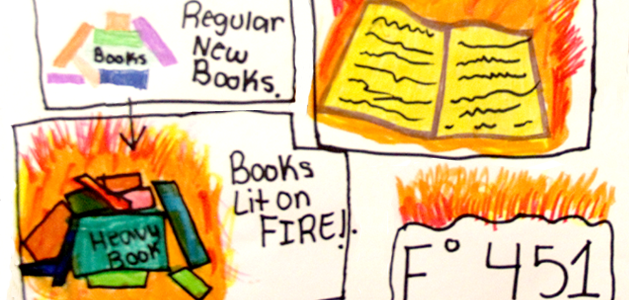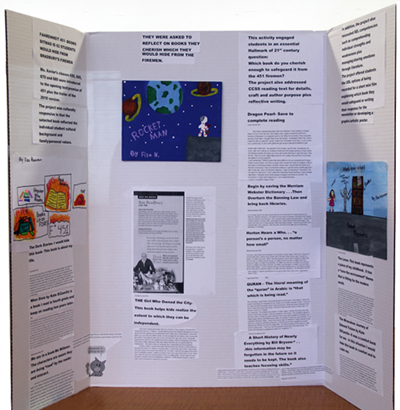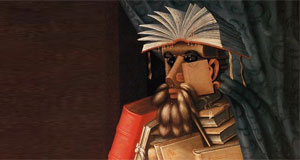Save from the Flames
What book would you save from the “firemen” in Ray Bradbury’s Fahrenheit 451?

Task
In Bradbury’s Fahrenheit 451, all books are burned in the name of safety. Imagine you are living in this dystopia. What book would you save from the flames? Why?
Engage
To launch this project, write the word “firefighter” on a whiteboard or collaborative mind mapping tool. Ask students to make free word- and feeling-associations with this term. It is likely that most of them will have positive associations and connect the word to saving lives and property.
Introduce students to Ray Bradbury’s Fahrenheit 451. You might read the entire novel with your class, but it isn’t necessary for the success of this lesson. For example, you can read the first 250 words of the novel aloud to give students a taste of the theme.
You could also share this section with students and ask them to do a close reading to explore how Bradbury uses language to make the reader feel certain ways. For example, Bradbury uses sensory language like “a wind turned dark with burning” to help the reader see and feel the setting and personification like “flapping pigeon-winged books” to make the scene come alive.
You could also watch the trailer for the 2018 HBO film adaptation.
The trailer showcases the emotional fever of both the “firemen” and the citizenry. Ask students to share how they felt after watching the trailer. What would it be like to live in this society?
Create
Ask your students to consider a book they would save from the flames. Have them ”turn and talk” with a classmate informally about their choice.
The book I would hide from the firemen in the society is Horton Hears A Who by Dr. Seuss. It’s not the entire book I cherish, but a certain part of the book. When Horton says “a person’s a person no matter how small.” When I read that sentence I like to think it means no matter how short you are, no matter how tall you are, no matter how old you are, no matter how much money you make, no matter if you are poor, no matter if you are rich, no matter if you have an old car, no matter if you have a nice car, no matter if you are black, no matter if you are white--none of that matters. You are a person and you should be treated as one. You deserve respect as any other person deserves respect, no matter who that individual is. All individuals merit the same respect. I could be overthinking this but this is what I like to think when I read Horton Hears A Who.
—Mikhail Bhuiyan
Once students have decided on the book they would save, have them complete a cluster graphic organizer to identify features of the character, story, or experience that contributes to their opinion.

Download a Cluster organizer
To help them craft a stronger opinion, help them zero in on the specific reasons the feel connected to this book. For example, did they choose the title because:
- of the way a book was acquired?
- of expertise the book gave them?
- a parent read this story to them?
- the book has a character they can relate to?
- the book addresses an issue passionate to them?
To help students find these personal connections without stress, you may want to begin the writing process with a simple free write or journal-style reflection that will not be evaluated.
Have students revisit the cluster diagrams and reflections and begin crafting their opinion piece.
Provide struggling writers with an O-R-E-O graphic organizer to help them craft their writing, by stating their Opinion, Reason, Example, and restating their Opinion.
Ask students to share rough drafts with a partner for feedback before sharing with you. Then, provide additional ideas and feedback students can use to transform the rough draft into a final product they are proud to share.
One book that I will hide from the firemen in the society is The Lorax by Dr. Seuss. One reason that I would hide this book and protect it is because I liked this book. It teaches about the world and its possible future. We are destroying the environment. I don’t want this needed message to be burnt by the firemen. Another reason that I want to hide this book is because I still remember that my mom read the book aloud to me. I always liked the story. It interests me that people would do anything for money or power. Yet there is always a person who tries to stop them. A final reason that I want to protect this book is because when I used to go to my local library, I would search for the book around the library. Then I would read it. I had a limited time in the library, so I couldn’t finish the book. Finally my mom bought the book at the bookshop. Every time I read the book, I would just look at the illustrations for some time. In the end, this is why I want to protect the book, The Lorax, from the firemen that burn the books under that society’s law. It is a piece of my childhood. It has a “save the environment” theme that is fitting to the modern day world.
— Giovanni Herrera
Share
Have students share their written or oral opinions with your class or another class at the same age level.
Invite your librarian or media specialist, local authors, or community book club members to join the presentations and share insights and comments that extend student thinking.
If students are sharing oral presentations, have other students capture these presentations to video. Share these recordings or student-written reflections on your website. This makes it easy for at-home learners to listen and share their opinions and provides all students with an opportunity to share book choices and react to others.

After students have shared their opinions, hold a discussion to get students to reflect on what they have heard and learned, prompting with questions like:
- Are there any new books you want to read? What prompted your decision?
- What new feelings do you have about books?
- How will you think differently now about the books you choose to read?
Assessment
Use the cluster and OREO graphic organizers along with the initial writing drafts for formative assessment purposes. Use the final project as a summative assessment of opinion writing.
Create a checklist or rubric to help your emerging writers remember and consider what their opinion writing and/or their oral presentation should include.
Use the discussions after the presentation to evaluate student thinking.
Resources
Ray Bradbury. Fahrenheit 451. ISBN: 0345342968
Gholdy Muhammad. Cultivating Genius: An Equity Framework for Culturally and Historically Responsive Literacy. ISBN: 1338594893
Irene C. Fountas and Gay Su Pinnell. Guiding Readers and Writers (Grades 3-6): Teaching, Comprehension, Genre, and Content Literacy. ISBN: 0325003106
Trent University - How to Write a Reflection Paper
Ditmas IS62 - Student Samples
One book I would personally hide from firemen in this society is The Girl Who Owned the City by O.T Nelson. I would hide this book from firemen because it is a story about how kids needing to be independent and to take care of themselves. In the book there is a virus that only affects adults. So the protagonist Lisa Nelson who is living with her brother Tod needs to take care of him and have him take care of her. Eventually Lisa joins the kids from the neighborhood and creates a safe and amazing community. This book is really inspiring to help kids realize that they can to a great extent be independent. This book is also an amazing story I personally find very intriguing.
Another reason I would personally hide this book from firemen in this society is because the author O.T Nelson is a great author. I found this book online. I was bored and was trying to find books that interest me. So when I read the first page of this book I was immediately hooked. I asked my sister to buy me a copy of the book. So far I think I have read the book five times because I think it is really great. I would hide this book because I wouldn’t want the firefighters to destroy it. Other people should be able to read it and eventually be inspired by the book.
— Luisa Luna
Now I know I'm not the best reader, but I know I have read a lot of books. So in this situation I would most likely choose the book The Miraculous Journey of Edward Tulane by Kate Dicamillo. This isn't the most advanced reading level for me, but I only really care about the actual book itself. When I first read this book. I completely fell in love. It was a comfort book for me. This book was about Edward Tulane, a china rabbit who has got lost from his former owner, a little girl named Abilene. Abilene treated Edward Tulane with her utmost respect, she put him at the dinner table with her family and made handmade clothes for him. Abilene just reminds me of my family, especially my mother. This story reminds me how grateful I should be. So in this situation, I would hide this book to comfort me and to calm me.
— Narmeen Ahmad
One book I would personally hide from firemen in this society is Dragon Pearl. It is by Yoon Ha Lee. One reason why I want to hide this book from firemen is because it is a special book to me. Most of my books I have acquired are from book fairs. I bought them from the school — Scholastic Book Fair, which I paid for with my parents' money. Eight from Scholastic book fairs, or just books on a school trip. In 3rd or 4th grade we got to go to Barnes & Nobles to get books with a $50 limit. Ten percent of my books I got for free. Sometimes my mom, dad, and I will go to Cortelyou Road and find people giving out free books. Sometimes people will leave out a box with books that has a sign that says “free for all.” Then my mom might take some for me. Lastly, five percent of my books are gifted to me as presents. I only remember THREE books that were gifted to me as a present and Dragon Pearl is one of them. It is from a cousin who moved from here to Oregon (I think) and was a Christmas present. Another reason why I would hide this book from firemen is because I have not finished reading it. I got this book months ago but I still, to this day, have not finished reading it. I plan on finishing it. Therefore I do not want it to get burnt. I don’t really like rereading books because I have already read them. I already know what’s going to happen and there is no thrill. Yet sometimes I forget what happens so I can reread the book.
— Angmo Bhutik
Standards
Common Core Anchor Standards for English Language Arts - Grade 4-10
Reading Standards
Key Ideas and Details
1. Read closely to determine what the text says explicitly and to make logical inferences from it; cite specific textual evidence when writing or speaking to support conclusions drawn from the text.
Writing Standards
Text Type and Purpose
1. Write arguments to support claims in an analysis of substantive topics or texts using valid reasoning and relevant and sufficient evidence.
2. Write informative/explanatory texts to examine and convey complex ideas and information clearly and accurately through the effective selection, organization, and analysis of content.
Speaking and Listening Standards
Presentation of Knowledge and Ideas
4. Present information, findings, and supporting evidence such that listeners can follow the line of reasoning and the organization, development, and style are appropriate to task, purpose, and audience.
ISTE Standards for Students 2016:
6. Creative Communicator
Students communicate clearly and express themselves creatively for a variety of purposes using the platforms, tools, styles, formats and digital media appropriate to their goals. Students:
a. choose the appropriate platforms and tools for meeting the desired objectives of their creation or communication.
b. create original works or responsibly repurpose or remix digital resources into new creations.
d. publish or present content that customizes the message and medium for their intended audiences.











